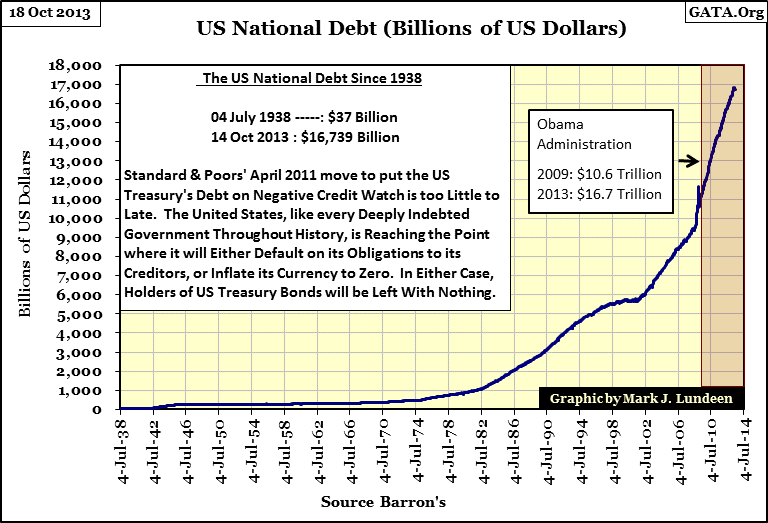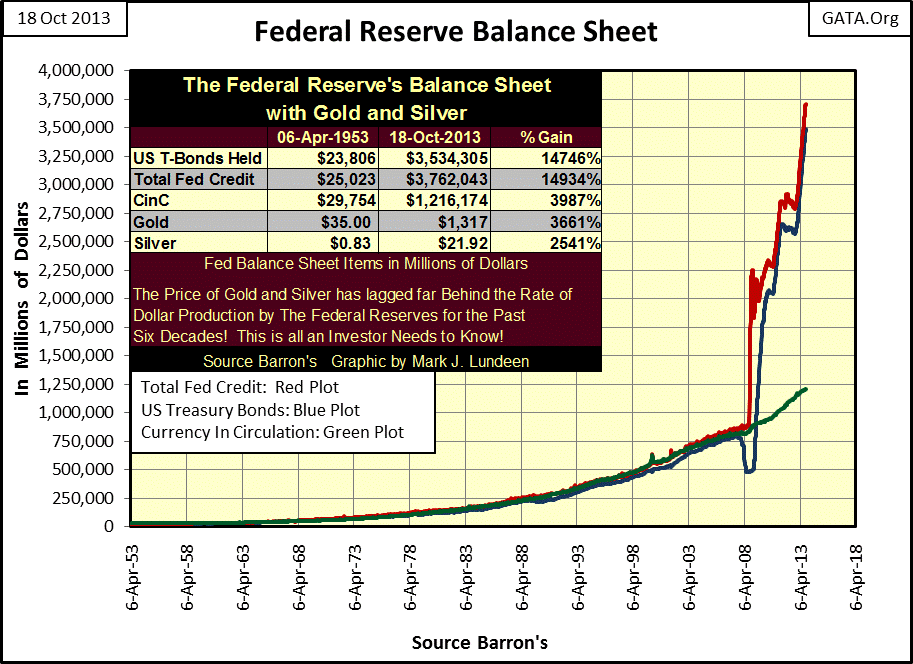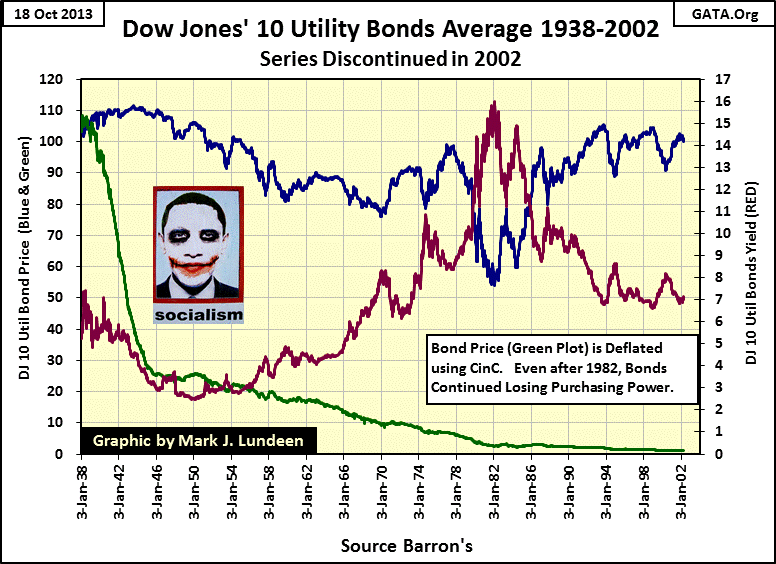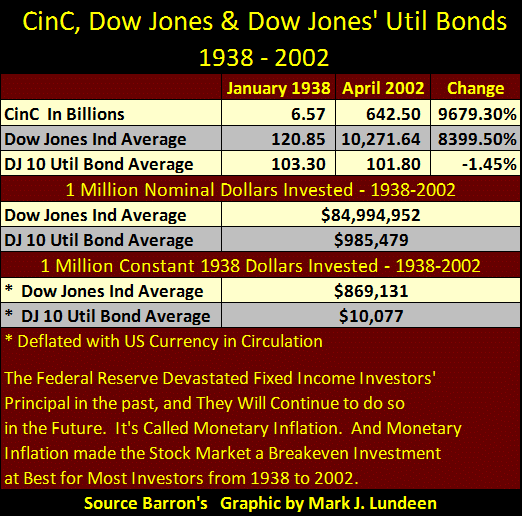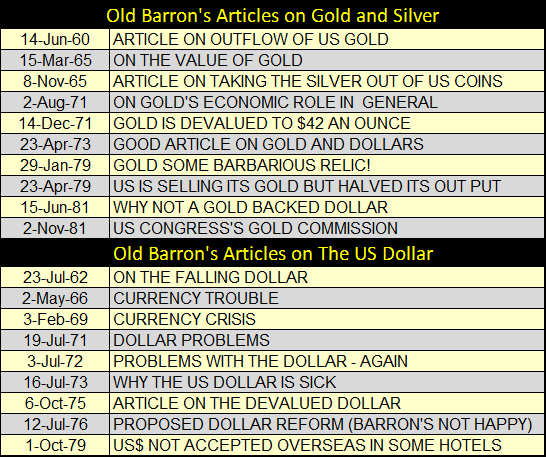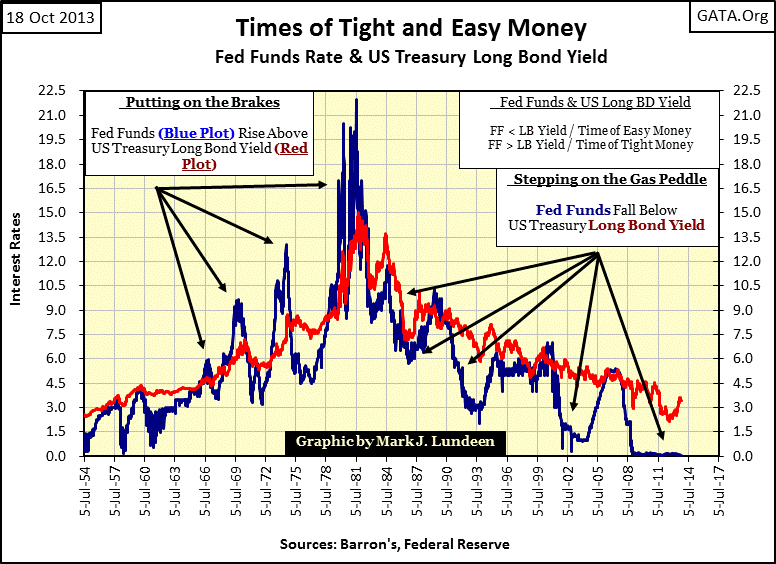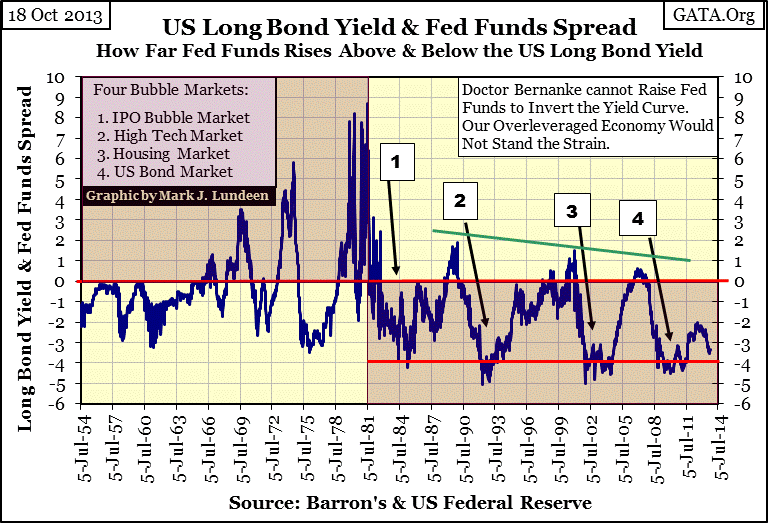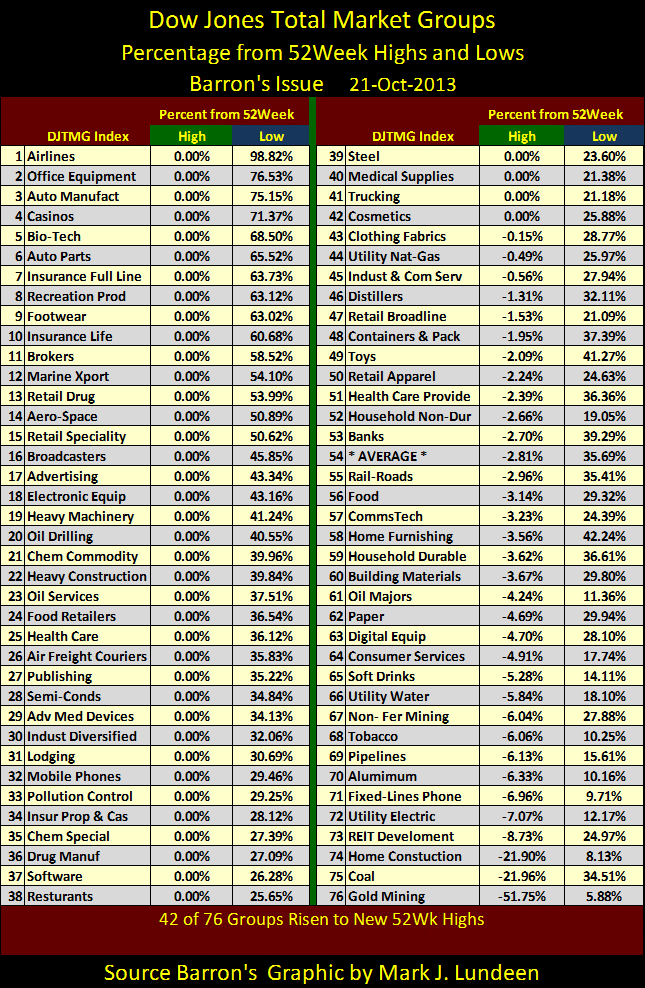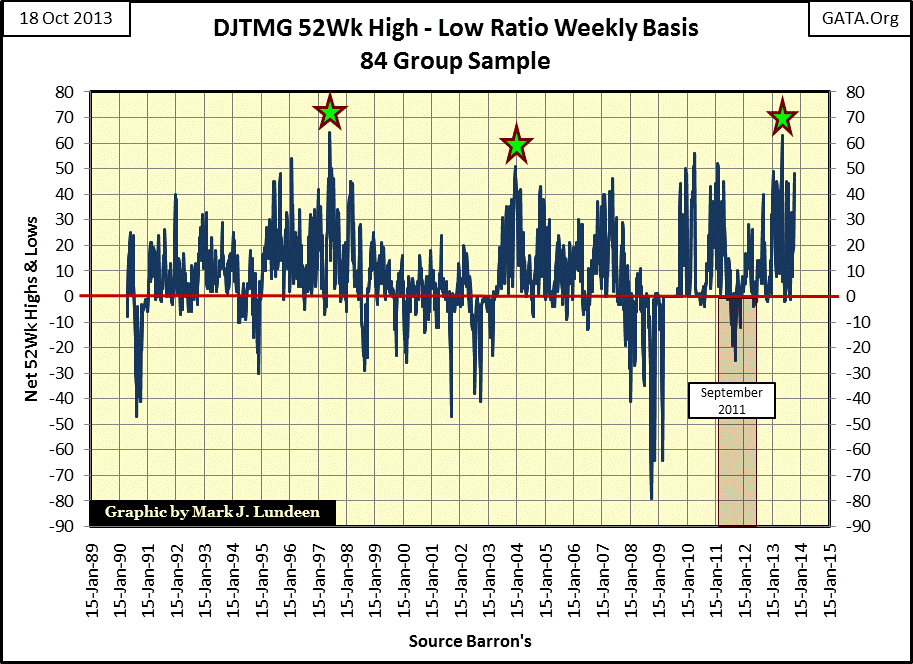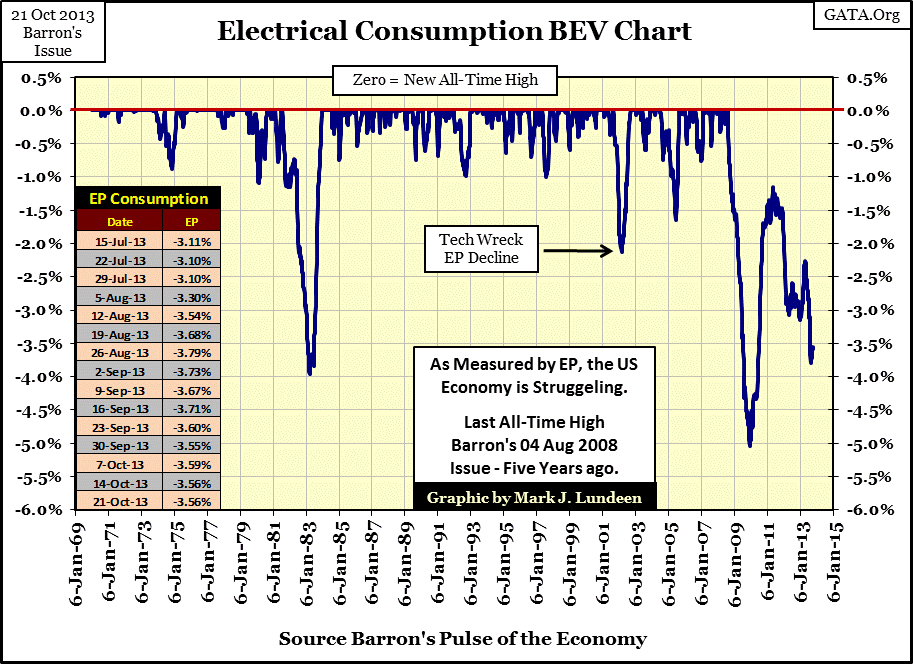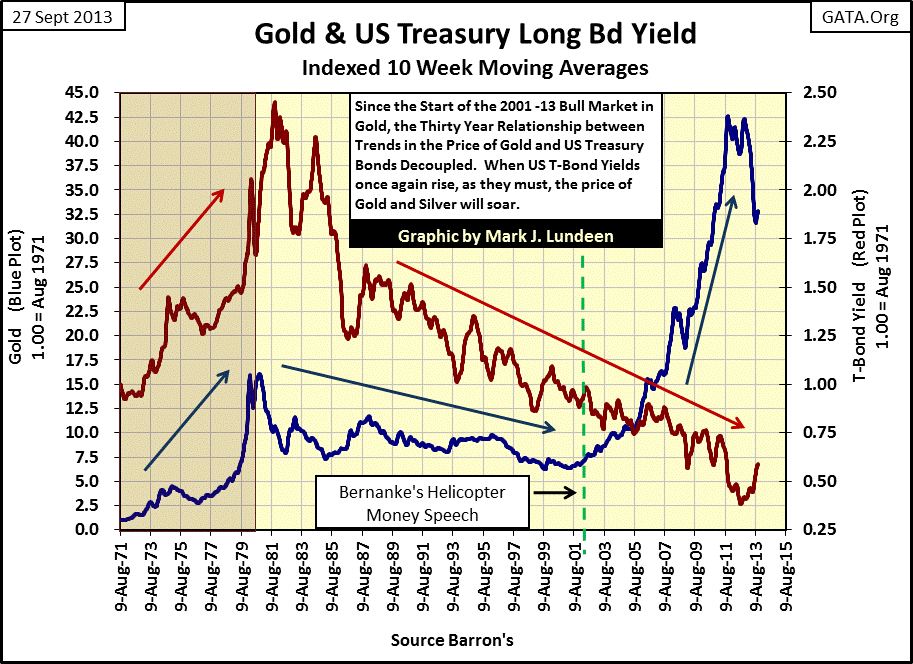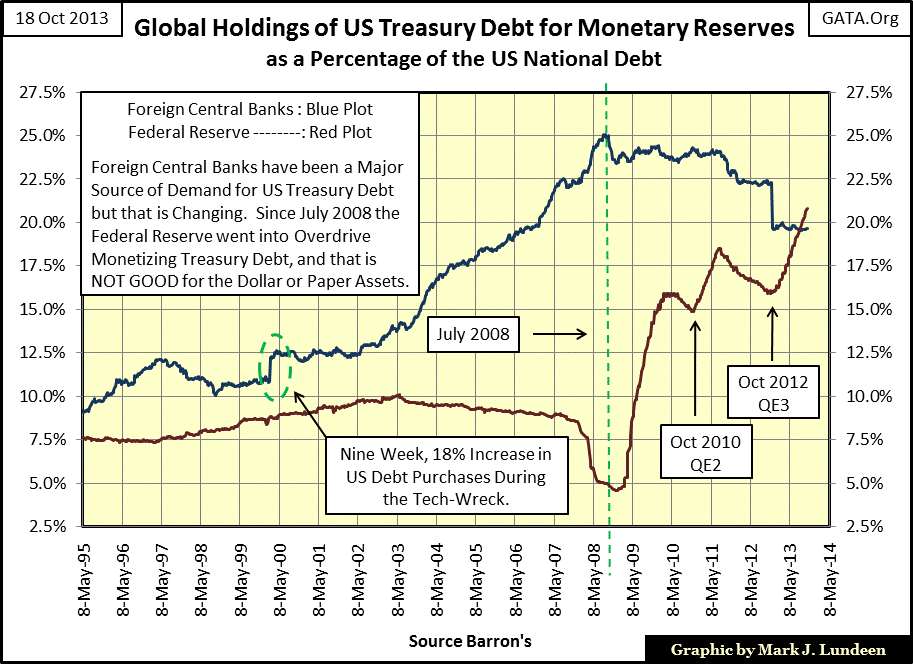The Market’s Lay Of The Land As 2014 Approaches
The latest “debt limit crisis” was resolved this week; for another few months anyway. Come January 2014, we can expect all congressional Democrats and the dopes in the Republican leadership to once again kick the can down the road to ruin yet again. The Dow Jones saw a 205 point (1.93%) advance on the news, as gold did what it always does on news that demonstrates how the managers of American “fiscal policy” are corrupt, insane or insanely corrupt; it went down. Never before in history have so many ignorant people possessed so much influence in a society. Yes, I’m talking about members of the main-stream media, some actually giddy that the crisis caused by a “small-radical-extremist element in the Republican party” was averted. My God, what are these people looking at? Not at the chart below! I can only hope members of the media run their personal finances as they demand Washington run the nation’s accounts.
I’m no fan of JP Morgan’s Jamie Dimon, but even he is warning Washington that they had best get their finances in order.
And the above liabilities of the Federal government are only those traded in the US Treasury market. The liabilities left uncharted are the Federal obligations for Social Security, Medicare, federal pensions and who knows what else? I see estimates for the total liabilities for the Federal Government from $100 to over $200 trillion. But no one really knows as the accounting standard used by Congress makes sure that no one can.
The Federal Reserve, which is neither Federal nor a monetary reserve, is expanding its balance sheet at near warp-speed in its effort to preserve our parasitic banking system that it represents. This grotesque expansion of credit and currency is being noticed. China, with a huge stake in the US dollar, is now talking about “de-Americanizing” global trade by removing the dollar’s “reserve status” with our trading partners.
The world may not be in a hurry to end America’s dollar hegemony, but you can be sure global trade understands the logic of China’s complaints no matter what the NY Times would have you believe. Why? Look at the charts above and below; can you blame them? These unsustainable trends in the national debt by the Federal Government, and the expansion in the US money supply by the Federal Reserve show no signs of reversing. In fact these trends are firmly on track towards their terminal end points, where American credit is acknowledged by all to be junk grade. That this isn’t already acknowledged to be so tells us denial is much more than just a river in Egypt.
Yet the media during our just concluded “debt crisis” spoke little if anything of these huge pending fiscal and monetary issues. In fact the media in the main were actually happy that the Democrats and their President received the needed support from the “adults” in the Republican party’s leadership. Thanks to these RINOs (Republicans In Name Only), Washington will now spend trillions more of borrowed money everyone knows Washington will never pay back in the same coin they borrowed. The media was also happy that finally a woman, Janet Yellen, will become the Chairman of the Fed. Here’s a link to an ABC News puff-piece on Yellen. Are these people in the media really this clueless? Yes they are!!
http://abcnews.go.com/blogs/politics/2013/10/5-surprising-things-about-janet-yellen/
So what actually does all this mean? National bankruptcy. Here’s a quote from Hemingway on a process that has played out many times, in many countries in history.
"How did you go bankrupt?"
"Two ways. Gradually, then suddenly."
- Ernest Hemingway's classic novel: The Sun Also Rises
Looking at these charts of Washington’s wastrel ways and the Federal Reserves’ manic expansion of the supply of dollars in the world, it’s not hard identifying when the United States stopped going bankrupt gradually, and moved its bankruptcy process into the sudden stage. But when did the US begin going bankrupt gradually? In the early 1950s, less than a decade after the US Senate ratified the Bretton Woods Accords and its $35 an ounce gold standard. When Washington first decided to issue more paper US dollars than it had monetized gold to back, it started a process that you and I will see end – the death of the US dollar as an economic asset. Our incumbent political class used these excess paper dollars to purchase goodwill from the voters, and pay for loyalty from their political supporters in corporate America, academia, and from community organizers who get even the dead out on Election day to vote for “hope and change.”
Soon after World War Two, the effects of this unwavering program of monetary inflation was felt in the US bond market with rising yields, as seen in the discontinued Dow Jones’ 10 Utility Bond Average’s red plot below.
In the next thirty two years (1950-1982), bond yields soared to double-digits as bond prices crumbled. Bond holders were hit by the double-whammy of collapsing bond and rising consumer prices. As we see in the table below, even though bond prices returned to their 1938 levels by 2002, monetary inflation inflicted a mortal wound on bond investors’ principle during these sixty-four years. The table also shows that the Dow Jones Industrial Average too failed to keep up with inflation when priced in constant 1938 dollars.
The American public is never exposed to historical data that runs counter to current Keynesian economic dogma. So, as the memory of the market events as recently as 2008 slip from public awareness, it’s not hard for most people to once again see rising asset prices as proof positive of a profitable bull market. This is also true of media “experts” on the markets and economy. However, the wealth created in minds of the public by the financial markets these many decades has mostly been a grand illusion. Over the long term, only the people in control of the Federal Reserve in Washington and Wall Street have benefitted from rising asset prices.
But I suspect China and our other trading partners are fully aware of the pernicious history of American financial assets now held as reserves by their central banks, insurance companies and pension funds. For the good reason that the US dollar is no longer as good as gold, they are looking for an exit door from the coming disaster. Asia has been buying gold and silver with abandon for over a decade. The amazing thing is they’ve been so patient with us for these past decades.
Returning to Hemingway’s concept of going bankrupt gradually until it overtakes one suddenly, let’s take a quick look at the changes in “monetary policy” since the 1950s. Up to 1981, memory of the gold standard and fear of monetary inflation was still well entrenched in the world of finance. Here are some of the articles on gold and the US dollar published by Barron’s decades ago. There are many more than these. But my point is that American inflation of the world’s reserve currency was a sore point to many in the markets from 1950 to 1981, and is again today with America’s trading partners, whether you hear about it or not in the financial media. Geeze Louise, China wants to “de-Americanize” global trade by removing the dollar’s “reserve status” in international trade. Such talk by a major supplier of manufactured goods to the United States, and the world is no small deal, but a shot across our bow.
After the bond market’s yields peaked in 1982, with the price of gold crashing down, attitudes in financial markets finally demonetized gold, as the US Treasury had done a decade earlier. With “liquidity” from the Federal Reserve flowing into financial asset valuations for the next two decades instead of the prices in consumer goods, the Federal Reserve was inflating bubbles in financial assets around the globe and everybody loved them for it. Alan Greenspan at one time was one of the most recognizable people in the world.
Living in Greenspan’s bubble was pleasurable. “Market experts” knew returning to the gold standard would only ruin the party. So, the world forgot about the dangers of monetary inflation and the virtues of a currency whose expansion was limited by precious metals reserves. But the good times of the past few decades were all a pipe dream that came crashing down in 2000-2002 and again in 2007-09. One day the joys of today’s “bull market” will for one more time, and likely for the last time, come crashing down again.
These changes in the market’s perception of monetary inflation are seen in the chart below displaying times of tight and easy money from 1954 to the present. Times of “tight money” are seen as periods where the blue fed funds plot rises above the red US Treasury’s long bond’s yield. This is also known as “inverting the yield curve.” “Easy money” are those times where the blue fed funds plot are declining and ultimately fall below the red US Treasury long bond’s yield. Before 1982, tight money (checking inflation) dominated “monetary policy”; after 1982 monetary policy became recklessly loose as monetary inflation was allowed to run riot. The Federal Reserve nailed its fed funds rate to the floor during the credit crisis. Since December 2008, fed funds have effectively been 0%. Other than dropping pallets of $100 bills from helicopters, the Federal Reserve can’t make “monetary policy” any looser.
Next is a chart of the interest rate spread for the fed funds rate and the US Treasury long bond’s yield; a different view of the data above. From 1954 to 1982, with bond yields and consumer prices rising, the Federal Reserve (the engine of inflation) was forced to frequently tighten its “monetary policy.” Note that each tightening cycle during the 1960s and 70s became more extreme than the one before it. The world was still resentful of Washington’s unilateral termination of the Bretton’s Woods $35 an ounce gold standard, so it had to increase each inversion of the yield curve to maintain any credibility as an “inflation fighter.”
The myth of the Federal Reserve being an inflation fighter is absurd. But its academic apologists have never associated the Federal Reserve’s Open Market Committee’s activities with inflationary price increases in consumer prices; not to the public. Inflationary price increases in financial assets are described as “economic growth.” Price Inflation has always been portrayed to the public as some nebulous market force that regrettably forced the Federal Reserve’s hand to tighten the money supply and bring about a controlled, if very unpleasant economic recession by raising interest rates.
After 1982, “monetary policy” underwent a revolution as bond yields declined and consumer prices stabilized, if not actually declined. With “monetary policy” now inflating popular bubbles in financial assets, (not increasing consumer prices) there was no public pressure to tighten its “monetary policy.” So the Federal Reserve seldom increased it fed fund rate above the US Treasury long bond’s yield from 1982 to today. But note that after 1982, when the Federal Reserve did invert the yield curve, it did so by only a tiny amount. But each time they did, a financial asset bubble was terminated. The first three bubbles listed in the chart above all were terminated when the Federal Reserve inverted the yield curve by just a tad. No doubt about it, wealth today is a fragile thing.
How the forth bubble in the US Treasury market (and other markets as well) terminates is a bit of a puzzle to me. The Federal Reserve cannot raise its fed funds rate without causing many hundreds of trillions of dollars in interest rate derivatives on the books of the US banking system coming into the money. Wall Street cannot honor its specific performance obligations on such a vast sum of liabilities. So, we can trust the Federal Reserve not increase its fed funds rate in the foreseeable future no matter who is Chairman at the Federal Reserve. However, the bond markets are seeing bond yields increase in spite of the Doctor Bernanke’s QE program. In effect this places the bond market, not the Federal Reserve, in control of how tight “monetary policy” is, and rising bond yields are making monetary policy looser.
Currently, the Federal Reserve’s loosest monetary policy since 1954 had occurred in the early 1990s and again in 2002 when the fed funds rate was five percentage points below the US Treasury long bond yield. As bond yields continue to rise (and they will), we’ll see the plot in the chart above to first descend to the -5% line, and then continue below the -6% line if the Federal Reserve does not increase its fed funds rate. The Federal Reserve’s most likely response will be to increase its monthly QE quota of US Treasury bonds to keep the yield curve under control. But that will only cause more US Treasury bonds held overseas to be sold.
No one knows when this party is going to crash. But the Wall Street bulls are partying hardy as we see in the following table. Forty two of the DJTMG’s seventy six groups saw a new 52Wk high at Friday’s close. That is a lot! And then all the groups from #43-64 are less than 5% from making a new 52Wk high. Doctor Bernanke’s “liquidity injections” are moving the stock market up in an impressive fashion.
The Gold Miners (#76) are at the bottom; 52% below their 52Wk high and only 5.88% off their 52Wk bottom. Should I recommend selling the miners and buying the airlines (#1)? Well as I’ve said before, I’m not a financial advisor. As long as you don’t send me a bill to reimburse you for any loss you took reading me, I promise not to demand a percentage of your profits my articles gave you. That said, the time to have entered this market was in September 2011, when in the chart below the DJTMG saw a large net negative number of 52Wk High and Low data. But in September 2011, few people were thinking of buying as it was a bad market, as Washington was in its last debt limit crisis. Two years ago, people were in a hurry to sell, which is usually the time to buy. Did I buy two years ago? Nope. I’m still waiting for Mr Bear to come back and finish what he started in 2008.
As DJTMG 52Wk H&L data is something only I seem to do, my readers could use NYSE’s 52Wk H&L data to gauge when the stock market is under or overpriced. And right now, I suspect anyone who was smart enough to buy in September 2011, is thinking about locking in some of their profits from the two year bull-run.
But who knows what is going to happen? The Federal Reserve is determined to keep assets values going up, but at some point Mr Bear will have his way with the Best and the Brightest at the Federal Reserve and their bull market. 2014 is an election year, so no politician is going to do anything to interfere. But this bull is only rising on hot-air being blown into it by The-Powers-That-Be. The economy itself isn’t supporting corporate profits. With the high unemployment we currently have, how could it? And then there is the EP chart below, proving that business activity in the United States has been languishing for the past five years.
Apparently only a few care that the stock market is in a bubble. In fact most people feel good that the Federal Reserve is fighting asset-price deflation. But there really are lots of structural problems out there that one day will come crashing down on Wall Street, and then the party comes crashing down with it. The stock market’s risk reward ratio today just doesn’t seem to justify risking money in it, not when the potential gains in gold, silver and the mining shares are explosive.
I expect the key to the market’s future will ultimately be found in the bond market, which is currently in a bubble thanks to the Federal Reserve’s QE program. I believe the bond market’s bubble goes back to when Doctor Bernanke made his Helicopter speech in November 2002. Or the same point in time when gold began going up as the T-bond’s yield continued going down (chart below). After all, declining bond yields are an indication of growing confidence of the financial system. Not so rising gold and silver prices; which are an indication of declining confidence in the financial system. So since 2001, someone has to be wrong, and I don’t believe it’s the people buying gold and silver.
The recent decline in the price of gold in this chart looks bad. But every long term bull market has gut-check corrections; sharp price declines deep enough to scare most investors out of the bull market. I expect history will ultimately prove that this is the case for the precious metal market’s current decline. Anyways, the selling pressure forcing the price of gold down is coming from the futures market. In other words the selling of digital contracts by banks promising delivery of millions of ounces of gold that doesn’t exist now, or will exist in the future.
The government regulators’ at the CFTC knows what is happening in the gold and silver futures markets and do nothing about it. Is the government manipulating the markets? One of the reasons (finger prints) leading me to believe that it is, is gold’s powerful reversal off its twenty year bear market bottom in 2001, * AS * bond yields continued declining for the next eleven years (2001-12). Look at gold’s blue plot above. During these eleven years gold moved up from $255 to $1888. This is a huge move (a vote of no confidence) that has so far failed to catch the attention of investment advisors or the general public. But one day it will.
So who is buying the gold and silver? Well you don’t read about who is buying gold in the daily newspapers, or on TV. But the same foreign central banks (Blue Plot below) who have been walking away from the US Treasury market for the past five years have been huge buyers of the old monetary metals in the spot-markets. Over the past few years Asian central banks have bought thousands of tons of gold, and more importantly, shipped it home far away from London and New York.
How have America’s “policy makers” responded to this foreign central bank "sell the US dollar and buy gold" trade? Well, since the foreign central banks became net-sellers of US T-bonds in July 2008, the Federal Reserve’s position in the US Treasury market (Red Plot above) has increased from 5% to over 20% to support lower yields, and higher prices in the bond market. Had the Federal Reserve failed to implement its Quantitative Easing (QE) programs after the mortgage debacle of 2007-09, bond yields today would be much higher than they now are; and so would be the price of gold and silver.
What has happen in the red plot above since 2008 is an act of desperation, and desperate people do desperate things when survival becomes an issue. One has to wonder what the status of the US Treasury’s gold reserves is. Is the 262 million ounces of US Treasury gold still there? And if so, who has title to it? It’s possible that the US Tank corps stationed at Fort Knox is actually defending 400 Oz bars of gold that now belongs to China and India. Think I’m wrong? I could be. So, write to your congressman and senators and ask them about the US gold reserves. From personal experience with my members of Congress, they they’d rather not place their signature on a document concerning the status of the American gold reserves. It seems that in 2013, some simple questions have only difficult answers.






